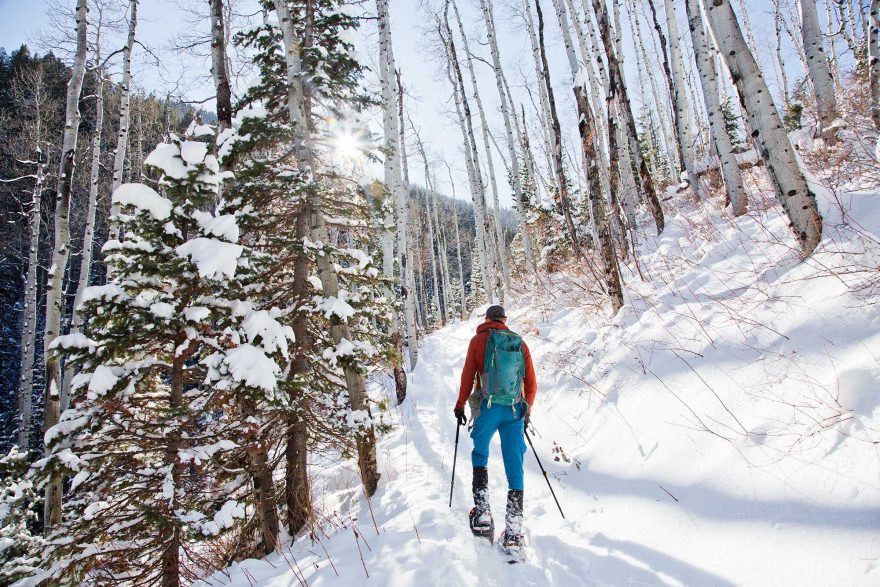
Image by Devansphotography, Shutterstock
Repairing the frames and webbing on snowshoes is similar to administering first aid, at least as far as some structural repair work is concerned. Damage to both wooden and modern metal/synthetic component snowshoes can be repaired to a certain extent based upon both the materials from which they are made and by how they are all combined to form the complete unit.
Depending upon the size and location of a crack or other breach in the snowshoe’s structure, many repairs — whether emergency fixes in the field or more thorough, lasting repairs at home — can be done with just a few tools and repair materials.
Wooden Frame Repair
Wooden frames are like our skeletal bones (a structure upon which our muscles are supported). A snowshoe’s frame is designed to support the network of webbing. This webbing distributes the wearer’s weight over a broader area of snow. You can splice a weakened section of the frame, just like a broken arm, providing at least temporary service in the field.
Many cracks in a frame can be repaired by splinting the section at the point of the break and then extending the splint onto the solid frame on both sides of the damage. Slats of wood, a whittled branch, or even better, a metal or plastic tent stake may provide at least temporary stoutness and support to the breached frame.
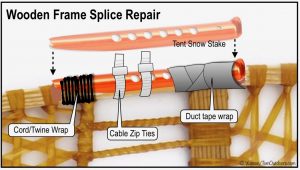
Illustration by Tom Watson
Once you center the splint on the crack, secure it in position by tightly wrapping duct tape or thin, strong twine or wire to secure the splint, and frame, in place. You might even be able to tighten hose clamps around the splint and frame to form a tight, gripping hold as well. A variety of these repair materials should be part of your winter field emergency repair kit.
The toe bar of the shoe takes a lot of stress. So if broken or cracked, you may need to retire the ‘shoes to a wall display and consider buying or making new snowshoes.
Repair the Webbing
Worn or damaged webbing breaks discovered in the field can sometimes be left alone, allowing the surrounding lacing to distribute the weight out from the damage. Otherwise, you may need to do a more extensive repair on your wooden snowshoes. Webbing repairs can be as basic as looping, wrapping and/or interweaving a section of new webbing material onto the old webbing or frame to provide support. You can purchase rawhide lacing to be including as part of snowshoe repair kits. However, connecting the new lacing to the end of the old piece can be a challenge.
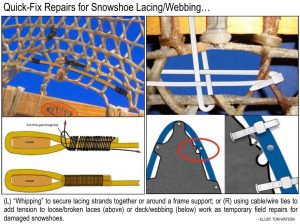
Illustration by Tom Watson
First, wrap the new end around a secure length of existing lacing stretched at a right angle to the broken lacing. Then secure the end of the replacement lace with several tight wraps of twine (like you’d use to whip the end of a rope). This technique will often bring up the strength of the webbing to near its original level.
If finding a source of rawhide lacing is a challenge, you can create your own sections of rawhide.
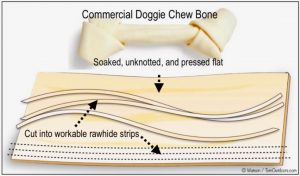
Illustration by Tom Watson
Get a large rolled and folded rawhide doggie chew bone at a pet sup-plies outlet and soak the “bone” in water until the knot is completely softened and loose. You can then unravel it and flatten it out. Cut narrow strips to length to use to repair short sections of the shoe’s webbing.
You can oftentimes temporarily lace together broken/torn straps and flaps on leather bindings with twine or paracord. Makeshift bindings from inner tubes are a common fix, too — another item for your field repair kit, perhaps?
Modern/Western Style Snowshoe Repairs
Tubular aluminum or molded synthetic frames can become bent, creased or otherwise compromised, too. They can be splinted (using quality duct tape/hose clamp or a section of telescoping repair tubing) depending on the location and extent of damage. Breaks/rips in the neoprene decking may be temporarily fixed using cable/wire ties depending upon where the damage is located and how extensive it is.
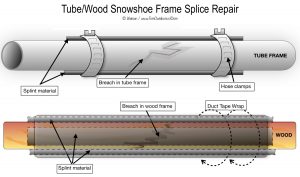
Illustration by Tom Watson
Duct tape can sometimes be used to patch neoprene/synthetic decking to at least help maintain temporary decking integrity (surface needs to be dry and clean for duct tape to adhere properly).
Webbing
Neoprene or other types of synthetic webbing material can rip at the lacing points along the frame. This section can often be reattached by making a hole along the edge of the decking material and looping a cable/wire tie through that hole and around the frame for a temporary cinching of the decking onto the snowshoe platform.
Consider stocking your repair kit with these supplies, along with appropriate glues/bond welding pastes compatible with the type of synthetic frame material to which it must bond.
» Related: Snowshoeing During Winter Is Growing In Popularity. Here’s Why.
Because of the integrity of synthetic components of modern snowshoes being integral to the functioning of the entire unit, some damage may necessitate getting a new pair of shoes.
A good maintenance program includes checking for repairs before/during/after the season as well as developing the know-how and materials to deal with them in the field.
Tom Watson is an award-winning outdoor safety and skills columnist and author of guide books on tent camping, hiking and self-reliant survival techniques. His website is www.TomOutdoors.com.
 Your Privacy Choices
Your Privacy Choices